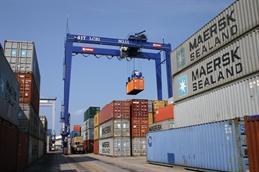
Rates have taken a tumble in recent weeks on the Asia/North Europe and Asia/Mediterranean trades, with all time lows recorded on both trades for westbound cargo over several consecutive weeks – a complete contrast to the record highs experienced back in August.
With China’s Golden Week holiday period something of distant memory, life for the shipping lines has shown little change in fortune, and rates have continued to resume their downward trend.
During the first week after the holidays, rates on the westbound Asia/North Europe trade dropped another US$84/teu to level out at US$738/teu, once again representing a new low for the year
The highs of over US$1,400/teu back in August now seem like a distant memory, with rates falling 49% in the ensuing ten-week period and, according to some brokers, little reason for the carriers to feel anything else but pessimistic for the build up to year end.
By mid-October, it was obvious that most of the General Rate Increases (GRI’s) planned for implementation during the month, particularly from the beginning of October, were non-starters.
The first half of the month has seen no more than four lines announce GRI’s for November 1 implementation, and lines continue to play “wait and see” on the success of the mid-October GRI’s earlier announced before deciding what to do in November.
November GRI’s announced pre-mid October concern less than a quarter of the lines involved in the Asia/North Europe and Asia/Mediterranean trades:
APL: US$800/teu effective November 1st
Hapag-Lloyd: US$750/teu effective November 3rd
NYK: US$920/teu effective November 1st
UASC: US$775/teu effective November 1st (Asia/North Europe only)
With the October GRI set to be a washout and rates currently well below break-even it can be certain that additional rate increases will be announced over the remaining months of the year.
According to brokers, there are reports that carriers looking to win the business of a major UK retailer have been offering annual contract rates under US$1,200/feu, indicating that the lines are still prepared to take significant volumes at a hefty loss in an attempt to fill slots.
Alternatively, that same carrier could agree the use of an index linked contract and then hedge their income at a level of US$2,400/feu, allowing them to effectively double the income earned on the same business.
As is well-known, rate fluctuation does not just depend on market conditions, but also relates to capacity deployment on a particular trade.
While lines have shown some reluctancy to withdraw complete services through the fourth quarter, there can be no doubt that sailing cancellations have been in abundance with the same capacity reduction equation involved.
According to the latest figures, capacity withdrawal Week 41 to Week 52 inclusive:
Maersk: 33,100 teu withdrawn
Mediterranean Shipping Co (MSC): 63,500 teu withdrawn
G6 Alliance: 44,000 teu withdrawn
CKYHE Alliance: 35,000 teu withdrawn
CSCL/UASC: 40,400 teu withdrawn
CMA-CGM: 22,600 teu withdrawn
Total capacity withdrawn from Asia/North Europe and Asia/Mediterranean trades in Q4/14: 238,600 teu which equates to approximately 13% of the total capacity deployed on the trades.
By Paul Richardson
Sea Freight Correspondent | London



